Assessing the Available Landslide Susceptibility Map and Inventory for the Municipality of Rio de Janeiro, Brazil: Potentials and Challenges for Data-Driven Applications
Abstract
1. Introduction
- Help establishing a database of landslide occurrences, originally stored as PDF (Portable Document Format) files, enabling researchers and public administrators to have a spatial view of where landslides most frequently occur in the city;
- Critically analyze the current susceptibility map (Reference Map), contrasting and comparing it with the recorded occurrences in recent years;
- Assessing and/or recommending the use of data-driven models in the production of susceptibility mappings.
2. Study Area
2.1. Climatic, Seasonal, Rainfall, and Morphological Characterization
2.2. Key Definitions
- Landslide inventory: A compilation containing information about geotechnical event occurrences in a specific area, typically including location, classification, volume, activity, occurrence date, and other relevant characteristics [42,43]. A well-prepared inventory links slope failures to terrain conditions, supports model validation, and is essential for integrating slope stability into land-use planning [42].
- Landslide susceptibility: Mapping that estimates the relative likelihood of landslides occurring across spatial units under current environmental conditions [44,45,46,47]. Susceptibility maps express this likelihood either qualitatively or quantitatively, depending on the methodology, and are a core tool for anticipating hazardous areas and informing territorial planning. Serving as a decision-making aid in urban development [38,47].
2.3. Methods for Landslide Mapping
3. Materials and Methods
3.1. Materials
3.1.1. Reference Map: The Existing Susceptibility Map
3.1.2. Landslide Inventory
3.1.3. Digital Terrain Models Obtained Through LASER Scanning
- Although the point cloud acquisition resolution is very dense, after removing points related to reflections from vegetation and buildings, many slope areas were interpolated at the sub-meter level, making it unsuitable to use a DTM resolution smaller than 1 m.
- Landslide occurrences (explained in more detail in the following section) were geolocated using expedited Global Navigation Satellite System (GNSS) devices (e.g., handheld receivers and cell phones), which, at best, achieve an accuracy no better than 5 m.
- High-density models result in excessive computational processing. Since better resolutions would exaggerate interpolations and not necessarily improve the accuracy of occurrence points, a resolution of 5 m per cell was deemed adequate.
3.2. Methods
3.2.1. Geolocation of Occurrences
3.2.2. Conversion of the Digital Terrain Model to Raster
3.2.3. Comparative Analysis of Occurrences with the Reference Susceptibility Map
3.2.4. Exploring GAM-Based Data-Driven Models
3.2.5. Filtering out Trivial Terrain and Noise Reduction
3.2.6. Inspection of Modeling Results
4. Results
4.1. Exploratory Data Analysis
4.2. Model Evaluation
4.3. Spatial Analysis of Occurrences on the Reference Map
4.4. Spatial Analysis of Occurrences on the New, Data-Driven Based Map
5. Discussion
5.1. Area Coverage Pertaining to Each Class
5.2. Landslide Inventory Occurrences and Their Distribution Across Susceptibility Classes
5.3. Assessing the Inventory
5.4. Potentials and Limitations of Rio de Janeiro’s Landslide Information for Modeling
6. Conclusions
Author Contributions
Funding
Institutional Review Board Statement
Informed Consent Statement
Data Availability Statement
Acknowledgments
Conflicts of Interest
Abbreviations
| ASPRS | American Society for Photogrammetry and Remote Sensing |
| APR | Administrative Planning Regions |
| DEM | Digital Elevation Model |
| DSM | Digital Surface Model |
| DTM | Digital Terrain Model |
| FDEMATEL-ANP | Fuzzy decision-making trial and evaluation laboratory |
| combining with the analytic network process | |
| GAM | Generalized Additive Models |
| Geo-Rio | Fundação Instituto de Geotécnica do Município do Rio de Janeiro |
| (Municipal Geotechnical Institute Foundation of Rio de Janeiro | |
| GIS | Geographic Information System |
| GNSS | Global Navigation Satellite System |
| IBGE | Instituto Brasileiro de Geografia e Estatística |
| (Brazilian Institute of Geography and Statistics) | |
| IPP | Instituto Municipal de Urbanismo Pereira Passos |
| (Pereira Passos Municipal Urban Planning Institute) | |
| IMU | Inertial Measurement Unit |
| LAS | LIDAR Aerial Survey |
| Laser | Light Amplification by Stimulated Emission of Radiation |
| LGPD | Lei Geral de Proteção de Dados |
| (General Data Protection Law—Brazil) | |
| MCDA | Multi-criteria Decision Analysis |
| ML | Machine Learning |
| NB | Naïve Bayes |
| RF | Random Forest |
| WoE | Weight of Evidence |
References
- Neiva d’Orsi, R.; Paes, N.M.; Magalhães, M.A.; Silva Junior, L.R.; Schiavinato Valente, L.R. Os 50 Maiores Acidentes Geológico-Geotécnicos na Cidade do Rio de Janeiro Entre 1966 e 2016; Fundação Instituto de Geotécnica do Município do Rio de Janeiro, Diretoria de Estudos e Projetos, Gerência de Programas Especiais: Rio de Janeiro, Brazil, 2016. [Google Scholar]
- Alves, E.; Souza, G.; Marra, R. Êxodo e sua contribuição à urbanização de 1950 a 2010. Rev. Política Agrícola 2011, 20, 82–83. [Google Scholar]
- Izaga, F.; Pereira, M.d.S. A mobilidade urbana na urbanização das favelas no Rio de Janeiro. Cad. Desenvolv. Flum. 2014, 4, 88–115. [Google Scholar] [CrossRef][Green Version]
- Matos, R. Migração e urbanização no Brasil. Rev. Geogr. 2012, 8, 7–23. [Google Scholar] [CrossRef]
- Parma, G.O.C. O risco ambiental aos deslizamentos de terra. Rev. Gestão Sustentabilidade Ambient. 2023, 12, e18741. [Google Scholar] [CrossRef]
- Mishra, A.N.; Maraun, D.; Knevels, R.; Truhetz, H.; Brenning, A.; Proske, H. Climate change amplified the 2009 extreme landslide event in Austria. Clim. Chang. 2023, 176, 124. [Google Scholar] [CrossRef]
- Mirandola, F.A.; Macedo, E.S.d. Proposta de classificação do tecnógeno para uso no mapeamento de áreas de risco de deslizamento. Quat. Environ. Geosci. 2014, 5, 66–81. [Google Scholar] [CrossRef]
- Bittencourt, B.K.; Cannabrava, M.P.; Del Rosario, T.K.; Hamilton, M.C.; Kampmann, M.E.; McGrath, J.T.; Ribeiro, B.B.; Gomes, J.O.; Lambert, J.H. Evaluating preparedness and resilience initiatives for distressed populations vulnerable to disasters in Rio de Janeiro, Brazil. In Proceedings of the 2013 IEEE Systems and Information Engineering Design Symposium, San Francisco, CA, USA, 25–28 March 2013; pp. 58–63. [Google Scholar] [CrossRef]
- Mendes Barbosa, L.; Walker, G. Epistemic injustice, risk mapping and climatic events: Analysing epistemic resistance in the context of favela removal in Rio de Janeiro. Geogr. Helv. 2020, 75, 381–391. [Google Scholar] [CrossRef]
- Instituto Municipal de Urbanismo Pereira Passos (IPP). SABREN-Sistema de Assentamentos de Baixa Renda. 2024. Available online: https://sabren-pcrj.hub.arcgis.com (accessed on 13 November 2024).
- Instituto Brasileiro de Geografia e Estatística (IBGE). Panorama de Favelas-Censo 2022. 2022. Available online: https://www.ibge.gov.br/geociencias/organizacao-do-territorio/tipologias-do-territorio/15788-favelas-e-comunidades-urbanas.html (accessed on 13 November 2024).
- Ronchi, S.; Arcidiacono, A. Adopting an Ecosystem Services-Based Approach for Flood Resilient Strategies: The Case of Rocinha Favela (Brazil). Sustainability 2019, 11, 4. [Google Scholar] [CrossRef]
- Lombardo, L.; Opitz, T.; Ardizzone, F.; Guzzetti, F.; Huser, R. Space-time landslide predictive modelling. Earth-Sci. Rev. 2020, 209, 103318. [Google Scholar] [CrossRef]
- Moreno, M.; Lombardo, L.; Crespi, A.; Zellner, P.J.; Mair, V.; Pittore, M.; van Westen, C.; Steger, S. Space-time data-driven modeling of precipitation-induced shallow landslides in South Tyrol, Italy. Sci. Total Environ. 2024, 912, 169166. [Google Scholar] [CrossRef]
- Steger, S.; Moreno, M.; Crespi, A.; Gariano, S.L.; Brunetti, M.T.; Melillo, M.; Peruccacci, S.; Marra, F.; de Vugt, L.; Zieher, T.; et al. Adopting the margin of stability for space-time landslide prediction—A data-driven approach for generating spatial dynamic thresholds. Geosci. Front. 2024, 15, 101822. [Google Scholar] [CrossRef]
- Instituto Brasileiro de Geografia e Estatística (IBGE). Cidades e Estados: Rio de Janeiro, Brazil. 2024. Available online: https://www.ibge.gov.br/cidades-e-estados/rj.html (accessed on 17 November 2024).
- da Silva, T.M.d.S.; Eduardo, C.C. Transformações geomorfológicas na cidade do Rio de Janeiro durante os séculos XIX e XX. Geo UERJ 2020, 37, e48492. [Google Scholar] [CrossRef]
- Coelho-Netto, A.L.; Avelar, A.S.; Fernandes, M.C.; Lacerda, W.A. Landslide susceptibility in a mountainous geoecosystem, Tijuca Massif, Rio de Janeiro: The role of morphometric subdivision of the terrain. Geomorphology 2007, 87, 120–131. [Google Scholar] [CrossRef]
- Silva, F.F.; Loureiro, H.A.S.; Silveira, T.S. Diagnóstico dos deslizamentos na cidade do Rio de Janeiro a partir das chuvas de abril de 2010: Estudo de caso do Morro dos Prazeres. Revista de Geografia (Recife) 2010, 27, 180–192. [Google Scholar]
- dos Santos Alvalá, R.C.; de Assis Dias, M.C.; Saito, S.M.; Stenner, C.; Franco, C.; Amadeu, P.; Ribeiro, J.; Souza de Moraes Santana, R.A.; Nobre, C.A. Mapping characteristics of at-risk population to disasters in the context of Brazilian early warning system. Int. J. Disaster Risk Reduct. 2019, 41, 101326. [Google Scholar] [CrossRef]
- Abelheira, M.A.; Salinas, G.; Soares, I.; Gomes Filho, S. Sirenes de alarme para deslizamentos de encostas: A experiência precursora da cidade do Rio de Janeiro. Rev. Mosaicos Estud. Governança Sustentabilidade E Inovação 2019, 1, 49–64. [Google Scholar] [CrossRef]
- Lacerda, W.A. The behavior of colluvial slopes in a tropical environment. In Proceedings of the 9th International Symposium on Landslides, Rio de Janeiro, Brazil, 28 June–2 July 2004; pp. 1183–1194. [Google Scholar]
- Chaves, F.L.; Gerscovich, D.M.S.; Sales, L.S.d. Correlação Chuva versus Escorregamento-Comunidade Formiga/Rio de Janeiro/Correlation Rain versus Sliding-Community Formiga/Rio de Janeiro. Braz. J. Dev. 2021, 7, 63901–63911. [Google Scholar] [CrossRef]
- Calvello, M.; d’Orsi, R.N.; Piciullo, L.; Paes, N.; Magalhaes, M.; Lacerda, W.A. The Rio de Janeiro early warning system for rainfall-induced landslides: Analysis of performance for the years 2010–2013. Int. J. Disaster Risk Reduct. 2015, 12, 3–15. [Google Scholar] [CrossRef]
- Calvello, M.; d’Orsi, R.; Piciullo, L.; Paes, N.; Magalhaes, M.; Coelho, R.; Lacerda, W. The Community-Based Alert and Alarm System for Rainfall Induced Landslides in Rio de Janeiro, Brazil. In Engineering Geology for Society and Territory, Volume 2 “Landslide Processes”, Proceedings of the XII Int. IAEG Congress, Torino, Italy, 13–19 September 2014; Springer: Cham, Switzerland, 2017; pp. 653–657. [Google Scholar] [CrossRef]
- Bogaard, T.; Greco, R. Invited perspectives: Hydrological perspectives on precipitation intensity-duration thresholds for landslide initiation: Proposing hydro-meteorological thresholds. Nat. Hazards Earth Syst. Sci. 2018, 18, 31–39. [Google Scholar] [CrossRef]
- Dantas, M.E. Geomorfologia do Estado do Rio de Janeiro; Estudo Geoambiental do Estado do Rio de Janeiro; CPRM–Serviço Geológico do Brasil: Brasília, Brazil, 2000. [Google Scholar]
- Monteiro, C.A.d.F.; Mendonça, F.d.A. Climatologia: Noções Básicas e Climas do Brasil; Editora Contexto: São Paulo, Brazil, 2003. [Google Scholar]
- Dereczynski, C.P.; de Oliveira, J.S.; Machado, C.O. Climatologia da precipitação no município do Rio de Janeiro. Rev. Bras. Meteorol. 2009, 24, 24–38. [Google Scholar] [CrossRef]
- Brito, T.T.; Oliveira-Júnior, J.F.; Lyra, G.B.; Gois, G.; Zeri, M. Multivariate analysis applied to monthly rainfall over Rio de Janeiro state, Brazil. Meteorol. Atmos. Phys. 2016, 129, 509–528. [Google Scholar] [CrossRef]
- Lyra, G.B.; Oliveira-Júnior, J.F.; Brito, T.T.; Gois, G.; Zeri, M. Interpolation methods for monthly rainfall data over the state of Rio de Janeiro, Brazil. Theor. Appl. Climatol. 2017, 130, 449–463. [Google Scholar] [CrossRef]
- Saldanha, R.; Akbarinia, R.; Pedroso, M.; Ribeiro, V.; Cardoso, C.; Pena, E.H.M.; Valduriez, P.; Porto, F. Zonal Statistics Datasets of Climate Indicators for Brazilian Municipalities. Environ. Data Sci. 2024, 3, e2. [Google Scholar] [CrossRef]
- Centro de Operações Rio. Maiores Chuvas–Alerta Rio, 2023. Available online: https://www.sistema-alerta-rio.com.br/maiores-chuvas/ (accessed on 30 March 2025).
- da Fonseca Martins, T. Pluviometria Crítica de Escorregamentos na Cidade do Rio de Janeiro: Comparação Entre Regiões e Períodos. Master’s Thesis, Universidade Federal do Rio de Janeiro (UFRJ), COPPE, Rio de Janeiro, Brasil, 2014. [Google Scholar]
- Fernandes, N.F.; Guimarães, R.F.; Gomes, R.A.; Vieira, B.C.; Montgomery, D.R.; Greenberg, H. Topographic controls of landslides in Rio de Janeiro: Field evidence and modeling. Catena 2004, 55, 163–181. [Google Scholar] [CrossRef]
- Gerscovich, D.; de Campos, T.; Vargas, E., Jr. Back analysis of a landslide in a residual soil slope in Rio de Janeiro, Brazil. In Proceedings of the Canadian Geotechnical Conference. Canadian Geotechnical Society, Halifax, NS, Canada, 20–23 September 2009. [Google Scholar]
- Avelar, A.S.; Coelho Netto, A.L.; Lacerda, W.A.; Becker, L.B.; Mendonça, M.B. Mechanisms of the recent catastrophic landslides in the mountainous range of Rio de Janeiro, Brazil. In Proceedings of the Second World Landslide Forum, International Consortium on Landslides, Rome, Italy, 3–9 October 2011. [Google Scholar]
- Fell, R.; Corominas, J.; Bonnard, C.; Cascini, L.; Leroi, E.; Savage, W.Z. Guidelines for landslide susceptibility, hazard and risk zoning for land use planning. Eng. Geol. 2008, 102, 85–98. [Google Scholar] [CrossRef]
- Cruden, D.M.; Varnes, D. Landslide Types and Processes. Landslide types and processes. In Landslides, Investigation and Mitigation; Turner, A.K., Schuster, R.L., Eds.; Transportation Research Board Special Report; National Academies Press: Washington, DC, USA, 1996; Volume 247, pp. 36–76. [Google Scholar]
- Varnes, D.J. Slope Movement. Types and Processes. In Landslides: Analysis and Control; Schuster, R., Krizek, R., National Research Council, Eds.; Transportation Research Board, National Academy Press: Washington, DC, USA, 1978; Volume Special Report 176, pp. 11–33. [Google Scholar]
- Hungr, O.; Leroueil, S.; Picarelli, L. The Varnes classification of landslide types, an update. Landslides 2014, 11, 167–194. [Google Scholar] [CrossRef]
- Guzzetti, F.; Mondini, A.C.; Cardinali, M.; Fiorucci, F.; Santangelo, M.; Chang, K.T. Landslide inventory maps: New tools for an old problem. Earth-Sci. Rev. 2012, 112, 42–66. [Google Scholar] [CrossRef]
- Hervás, J. Landslide Inventory. In Encyclopedia of Natural Hazards; Bobrowsky, P.T., Ed.; Springer: Dordrecht, The Netherland, 2013; pp. 610–611. [Google Scholar]
- Brabb, E.E. Innovative approaches to landslide hazard and risk mapping. In Proceedings of the 4th International Symposium on Landslides, Toronto, ON, Canada, 16–21 September 1984; Volume 1, pp. 307–324. [Google Scholar]
- Crozier, M.J.; Glade, T. Landslide hazard and risk: Issues, Concepts, and Approach. In Landslide Hazard and Risk; Glade, T., Anderson, M.G., Crozier, M.J., Eds.; Wiley: Chichester, UK, 2005; pp. 1–38. [Google Scholar] [CrossRef]
- Guzzetti, F. Landslide Hazard and Risk Assessment. Ph.D. Thesis, Rheinische Friedrich-Wilhelms-Universität, Bonn, Germany, 2005. [Google Scholar]
- Corominas, J.; van Westen, C.; Frattini, P.; Cascini, L.; Malet, J.P.; Fotopoulou, S.; Catani, F.; Van Den Eeckhaut, M.; Mavrouli, O.; Agliardi, F.; et al. Recommendations for the quantitative analysis of landslide risk. Bull. Eng. Geol. Environ. 2014, 73, 209–263. [Google Scholar] [CrossRef]
- Reichenbach, P.; Rossi, M.; Malamud, B.D.; Mihir, M.; Guzzetti, F. A review of statistically-based landslide susceptibility models. Earth-Sci. Rev. 2018, 180, 60–91. [Google Scholar] [CrossRef]
- Lima, P.; Steger, S.; Murillo-García, F.; Glade, T. Literature review and bibliometric analysis on data-driven assessment of landslide susceptibility. J. Mt. Sci. 2022, 19, 1670–1698. [Google Scholar] [CrossRef]
- Cascini, L. Applicability of landslide susceptibility and hazard zoning at different scales. Eng. Geol. 2008, 102, 164–177. [Google Scholar] [CrossRef]
- van Westen, C.J.; Castellanos, E.; Kuriakose, S.L. Spatial data for landslide susceptibility, hazard, and vulnerability assessment: An overview. Eng. Geol. 2008, 102, 112–131. [Google Scholar] [CrossRef]
- Shano, L.; Raghuvanshi, T.K.; Meten, M. Landslide susceptibility evaluation and hazard zonation techniques—A review. Geoenviron. Disasters 2020, 7, 18. [Google Scholar] [CrossRef]
- Brito, M.M.d.; Weber, E.J.; Silva Filho, L.C.P.d. Multi-criteria analysis applied to landslide susceptibility mapping. Rev. Bras. Geomorfol. 2017, 18, 719–735. [Google Scholar]
- Vojteková, J.; Vojtek, M. Assessment of landslide susceptibility at a local spatial scale applying the multi-criteria analysis and GIS: A case study from Slovakia. Geomat. Nat. Hazards Risk 2020, 11, 131–148. [Google Scholar] [CrossRef]
- Bera, A.; Mukhopadhyay, B.P.; Das, D. Landslide hazard zonation mapping using multi-criteria analysis with the help of GIS techniques: A case study from Eastern Himalayas, Namchi, South Sikkim. Nat. Hazards 2019, 96, 935–959. [Google Scholar] [CrossRef]
- Van Westen, C.; Van Asch, T.W.; Soeters, R. Landslide hazard and risk zonation—Why is it still so difficult? Bull. Eng. Geol. Environ. 2006, 65, 167–184. [Google Scholar] [CrossRef]
- Brenning, A. Statistical Geocomputing combining R and SAGA: The Example of Landslide susceptibility Analysis with generalized additive Models. In SAGA-Seconds Out; Böhner, J., Blaschke, T., Montanarella, L., Böhner, J., Eds.; Hamburger Beiträge zur Physischen Geographie und Landschaftsökologie, Universität Hamburg, Institut für Geographie: Hamburg, Germany, 2008. [Google Scholar]
- Lima, P.; Steger, S.; Glade, T. Counteracting flawed landslide data in statistically based landslide susceptibility modelling for very large areas: A national-scale assessment for Austria. Landslides 2021, 18, 3531–3546. [Google Scholar] [CrossRef]
- Montgomery, D.R.; Dietrich, W.E. A physically based model for the topographic control on shallow landsliding. Water Resour. Res. 1994, 30, 1153–1171. [Google Scholar] [CrossRef]
- Meten, M.; PrakashBhandary, N.; Yatabe, R. Effect of Landslide Factor Combinations on the Prediction Accuracy of Landslide Susceptibility Maps in the Blue Nile Gorge of Central Ethiopia. Geoenviron. Disasters 2015, 2, 9. [Google Scholar] [CrossRef]
- Silalahi, F.E.S.; Pamela; Arifianti, Y.; Hidayat, F. Landslide susceptibility assessment using frequency ratio model in Bogor, West Java, Indonesia. Geosci. Lett. 2019, 6, 10. [Google Scholar] [CrossRef]
- Addis, A. GIS-Based Landslide Susceptibility Mapping Using Frequency Ratio and Shannon Entropy Models in Dejen District, Northwestern Ethiopia. J. Eng. 2023, 2023, 1062388. [Google Scholar] [CrossRef]
- Wilopo, W.; Putra, D.P.E.; Fathani, T.F.; Pramaditya, A.; Tandirerung, R.; Erzagian, E. Comparison of two landslide hazard zonation methods in the volcanic terrain of Temanggung Regency, Central Java, Indonesia. J. Degrad. Min. Lands Manag. 2023, 10, 4537–4546. [Google Scholar] [CrossRef]
- Batar, A.K.; Watanabe, T. Landslide Susceptibility Mapping and Assessment Using Geospatial Platforms and Weights of Evidence (WoE) Method in the Indian Himalayan Region: Recent Developments, Gaps, and Future Directions. ISPRS Int. J. Geo-Inf. 2021, 10, 114. [Google Scholar] [CrossRef]
- Bernknopf, R.L.; Campbell, R.H.; Brookshire, D.S.; Shapiro, C.D. A Probabilistic Approach to Landslide Hazard Mapping in Cincinnati, Ohio, with Applications for Economic Evaluation. Environ. Eng. Geosci. 1988, 25, 39–56. [Google Scholar] [CrossRef]
- Chung, C.J.F.; Fabbri, A.G. Probabilistic prediction models for landslide hazard mapping. Photogramm. Eng. Remote Sens. 1999, 65, 1389–1399. [Google Scholar]
- Lee, S.; Pradhan, B. Landslide hazard mapping at Selangor, Malaysia using frequency ratio and logistic regression models. Landslides 2007, 4, 33–41. [Google Scholar] [CrossRef]
- Ayalew, L.; Yamagishi, H. The application of GIS-based logistic regression for landslide susceptibility mapping in the Kakuda-Yahiko Mountains, Central Japan. Geomorphology 2005, 65, 15–31. [Google Scholar] [CrossRef]
- Goetz, J.N.; Brenning, A.; Petschko, H.; Leopold, P. Evaluating machine learning and statistical prediction techniques for landslide susceptibility modeling. Comput. Geosci. 2015, 81, 1–11. [Google Scholar] [CrossRef]
- Ali, S.A.; Parvin, F.; Vojteková, J.; Costache, R.; Linh, N.T.T.; Pham, Q.B.; Vojtek, M.; Gigović, L.; Ahmad, A.; Ghorbani, M.A. GIS-based landslide susceptibility modeling: A comparison between fuzzy multi-criteria and machine learning algorithms. Geosci. Front. 2021, 12, 857–876. [Google Scholar] [CrossRef]
- Kadavi, P.R.; Lee, C.W.; Lee, S. Application of Ensemble-Based Machine Learning Models to Landslide Susceptibility Mapping. Remote Sens. 2018, 10, 1252. [Google Scholar] [CrossRef]
- Chen, X.; Chen, W. GIS-based landslide susceptibility assessment using optimized hybrid machine learning methods. Catena 2021, 196, 104833. [Google Scholar] [CrossRef]
- Brenning, A. Spatial prediction models for landslide hazards: Review, comparison and evaluation. Nat. Hazards Earth Syst. Sci. 2005, 5, 853–862. [Google Scholar] [CrossRef]
- Knevels, R.; Leopold, P.; Proske, H.; Wang, Z.; Brenning, A. Does Random Forest outperform the Generalized Additive Model? An evaluation based on rainfall-triggered landslides in the Styrian Basin, Austria. In Proceedings of the World Landslide Forum 6, Florence, Italy, 14–17 November 2023. [Google Scholar]
- Petschko, H.; Bell, R.; Glade, T. Landslide susceptibility modeling with generalized additive models—Facing the heterogeneity of large regions. In Landslides and Engineered Slopes: Protecting Society through Improved Understanding; Eberhardt, E., Froese, C., Turner, K.A., Leroueil, S., Eds.; Taylor & Francis: London, UK, 2012; Volume 1, pp. 769–775. [Google Scholar]
- Glade, T. Ranging Scales in Spatial Landslide Hazard and Risk Analysis; WIT Press: Southampton, UK, 2002; pp. 719–729. [Google Scholar]
- Prefeitura da Cidade do Rio de Janeiro. Data.Rio–Painel Interativo de Monitoramento e Prevenção a Desastres no Rio de Janeiro. 2024. Available online: https://www.data.rio/ (accessed on 4 November 2024).
- Kraus, K. Photogrammetry: Geometry from Images and Laser Scans; De Gruyter: Berlin, Germany; Boston, TX, USA, 2007. [Google Scholar] [CrossRef]
- Topocart Aerolevantamentos. Relatório de Execução de Mapeamento Aerofotogramétrico do Município do Rio de Janeiro por Mosaicos de Ortoimagens Digitais Coloridas Obtidas por Plataforma Aérea e Ortorretificadas de Acordo com Elevações (“True Ortho”); Modelo Digital de Elevações e Modelo Digital do Terreno por Perfilamento a LASER; Topocart Aerolevantamentos: Brasília, Brazil, 2019. [Google Scholar]
- American Society for Photogrammetry and Remote Sensing. LAS Specification 1.4-R14. 2019. Available online: https://www.usgs.gov/ngp-standards-and-specifications/clarify-intensity-requirement (accessed on 17 November 2024).
- LiDAR Brasil. Retornos e Classificação do Pulso Laser. 2024. Available online: https://www.ibm.com/br-pt/think/topics/lidar (accessed on 11 November 2024).
- Esri. XY Table to Point (Data Management)—ArcGIS Pro. 2024. Available online: https://pro.arcgis.com/en/pro-app/latest/tool-reference/data-management/xy-table-to-point.htm (accessed on 30 December 2024).
- van Diggelen, F.; Enge, P. The World’s first GPS MOOC and Worldwide Laboratory using Smartphones. In Proceedings of the 28th International Technical Meeting of the Satellite Division of The Institute of Navigation (ION GNSS+ 2015), Tampa, FL, USA, 14–18 September 2015; pp. 361–369. [Google Scholar]
- GNSS, I. High-Precision Positioning with Smartphone Measurements. 2024. Available online: https://insidegnss.com/high-precision-positioning-with-smartphone-measurements/ (accessed on 6 November 2024).
- Esri. LAS Dataset to Raster (Conversion)—ArcGIS Pro. 2024. Available online: https://pro.arcgis.com/en/pro-app/latest/tool-reference/conversion/las-dataset-to-raster.htm (accessed on 30 December 2024).
- Esri. Raster to Polygon (Conversion)—ArcGIS Pro. 2024. Available online: https://pro.arcgis.com/en/pro-app/latest/tool-reference/conversion/raster-to-polygon.htm (accessed on 30 December 2024).
- Esri. Spatial Join (Analysis)—ArcGIS Pro. 2024. Available online: https://pro.arcgis.com/en/pro-app/latest/tool-reference/analysis/spatial-join.htm (accessed on 30 December 2024).
- Petschko, H.; Brenning, A.; Bell, R.; Goetz, J.; Glade, T. Assessing the quality of landslide susceptibility maps—Case study Lower Austria. Nat. Hazards Earth Syst. Sci. 2014, 14, 95–118. [Google Scholar] [CrossRef]
- Brenning, A. Spatial cross-validation and bootstrap for the assessment of prediction rules in remote sensing: The R package sperrorest. In Proceedings of the International Geoscience and Remote Sensing Symposium (IGARSS), Munich, Germany, 22–27 July 2012; pp. 5372–5375. [Google Scholar] [CrossRef]
- Malamud, B.D.; Turcotte, D.L.; Guzzetti, F.; Reichenbach, P. Landslide inventories and their statistical properties. Earth Surf. Process. Landforms 2004, 29, 687–711. [Google Scholar] [CrossRef]
- Budimir, M.E.A.; Atkinson, P.M.; Lewis, H.G. A systematic review of landslide probability mapping using logistic regression. Landslides 2015, 12, 419–436. [Google Scholar] [CrossRef]
- Brenning, A. Benchmarking classifiers to optimally integrate terrain analysis and multispectral remote sensing in automatic rock glacier detection. Remote Sens. Environ. 2009, 113, 239–247. [Google Scholar] [CrossRef]
- Goetz, J.N.; Guthrie, R.H.; Brenning, A. Integrating physical and empirical landslide susceptibility models using generalized additive models. Geomorphology 2011, 129, 376–386. [Google Scholar] [CrossRef]
- Steger, S.; Glade, T. The challenge of “trivial areas” in statistical landslide susceptibility modelling. In Advancing Culture of Living with Landslides, Proceedings of the 4th World Landslide Forum, Ljubljana, Slovenia, 29 May–2 June 2017; Advances in Landslide Science; Springer International Publishing: Cham, Switzerland, 2017; Volume 2. [Google Scholar]
- ESRI. Focal Statistics (Spatial Analyst). 2023. Available online: https://pro.arcgis.com/en/pro-app/latest/tool-reference/spatial-analyst/focal-statistics.htm (accessed on 17 November 2024).
- Lin, Q.; Lima, P.; Steger, S.; Glade, T.; Jiang, T.; Zhang, J.; Liu, T.; Wang, Y. National-scale data-driven rainfall induced landslide susceptibility mapping for China by accounting for incomplete landslide data. Geosci. Front. 2021, 12, 101248. [Google Scholar] [CrossRef]
- Steger, S.; Brenning, A.; Bell, R.; Glade, T. The propagation of inventory-based positional errors into statistical landslide susceptibility models. Nat. Hazards Earth Syst. Sci. 2016, 16, 2729–2745. [Google Scholar] [CrossRef]

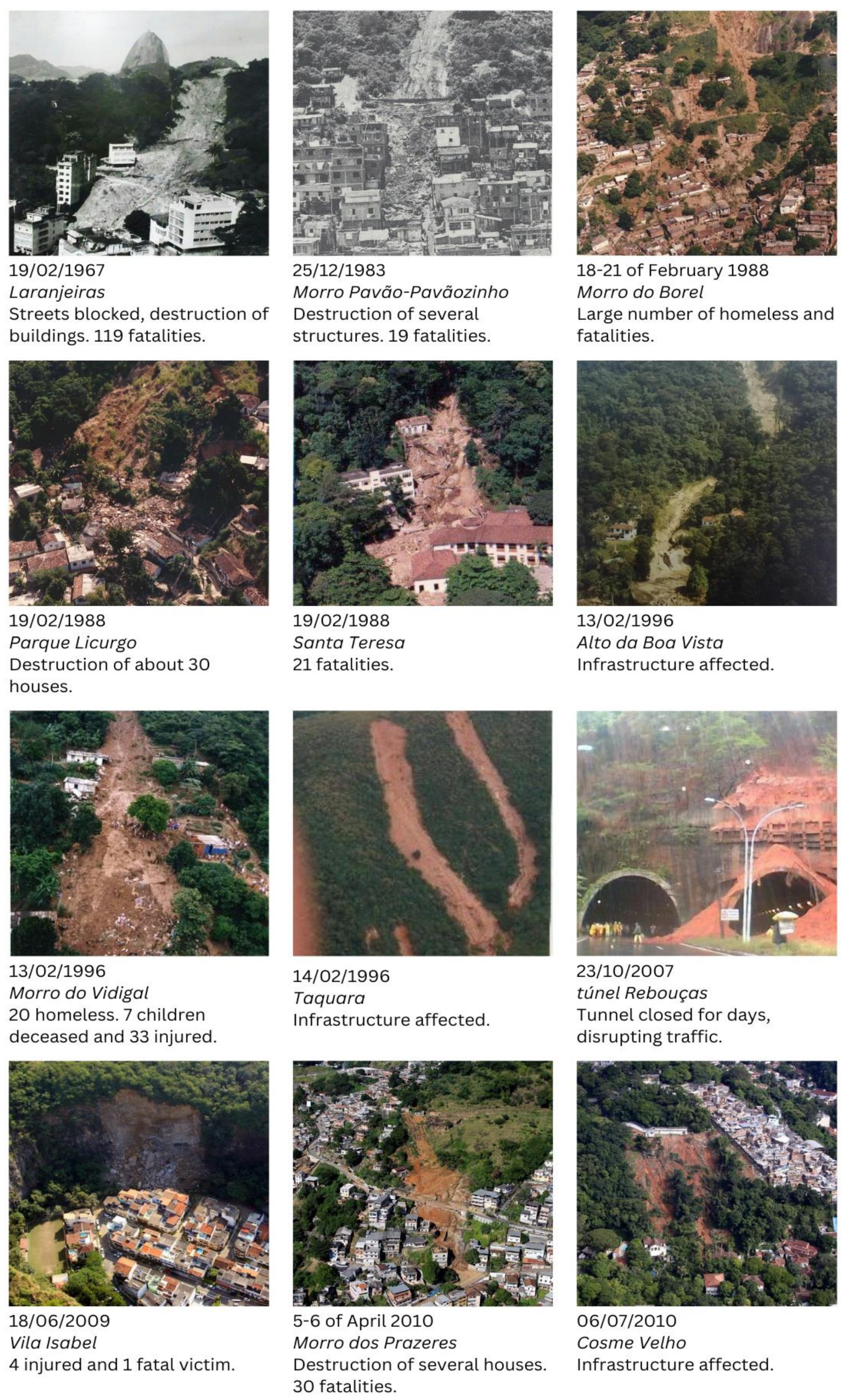
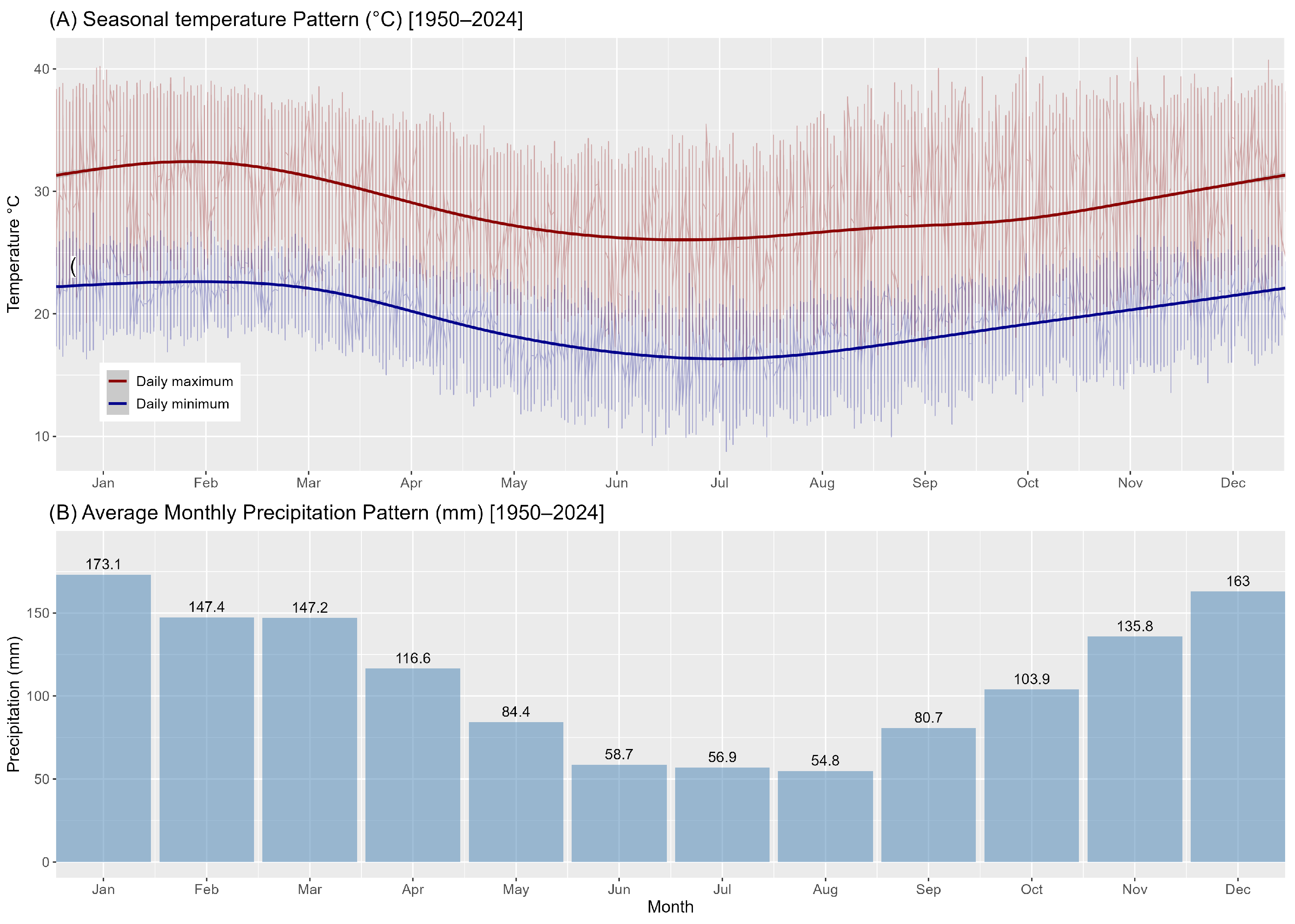
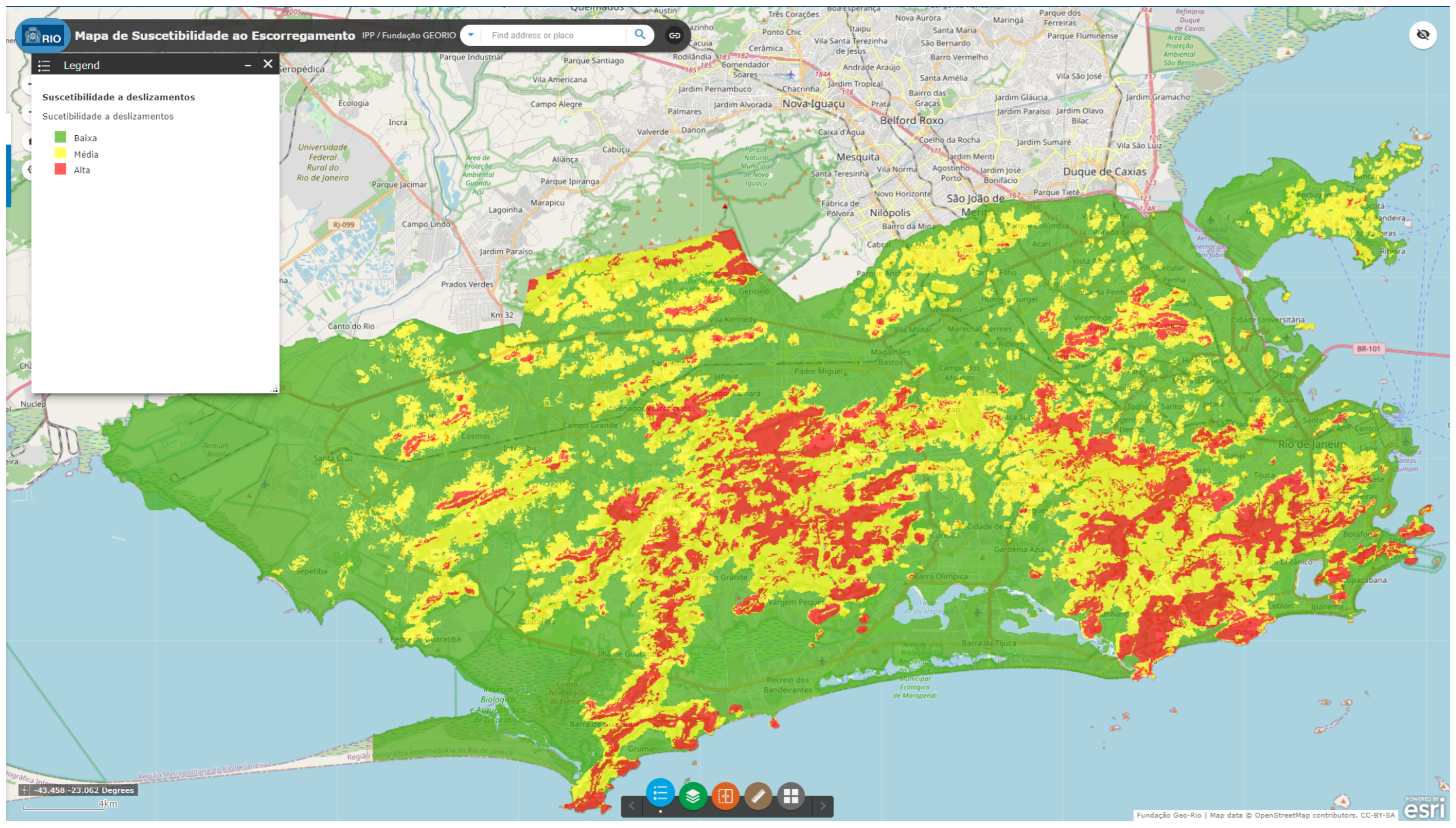
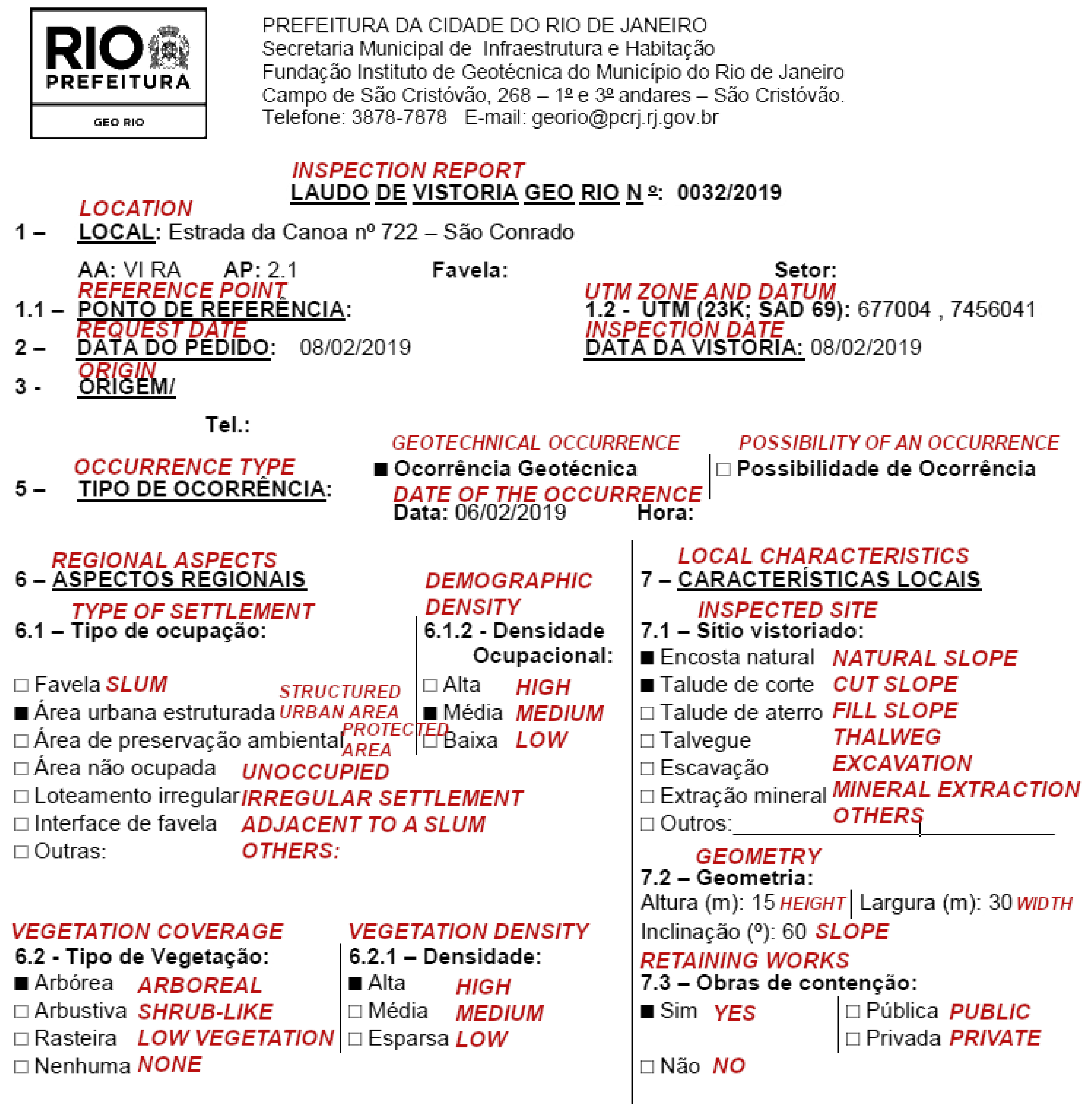



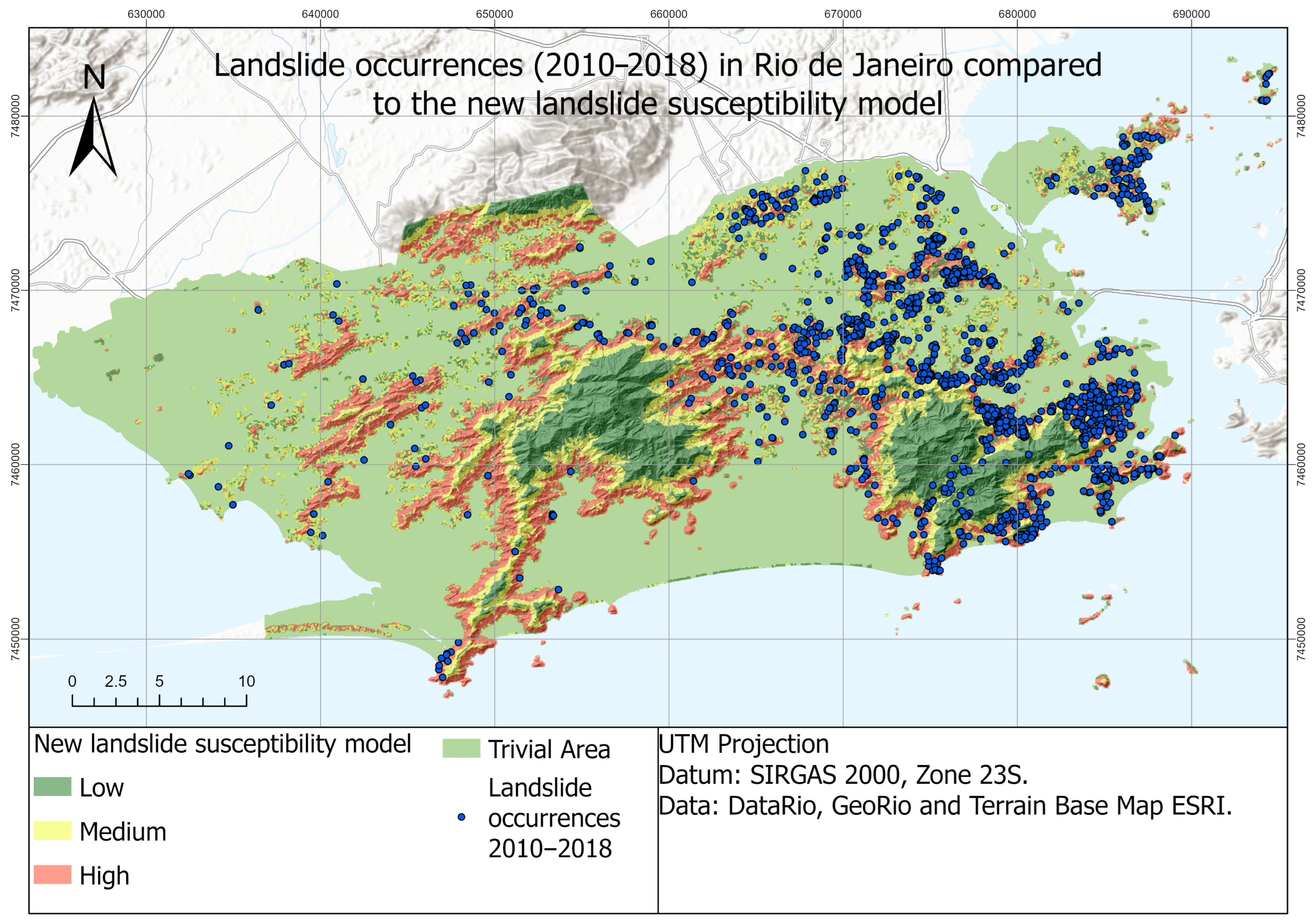
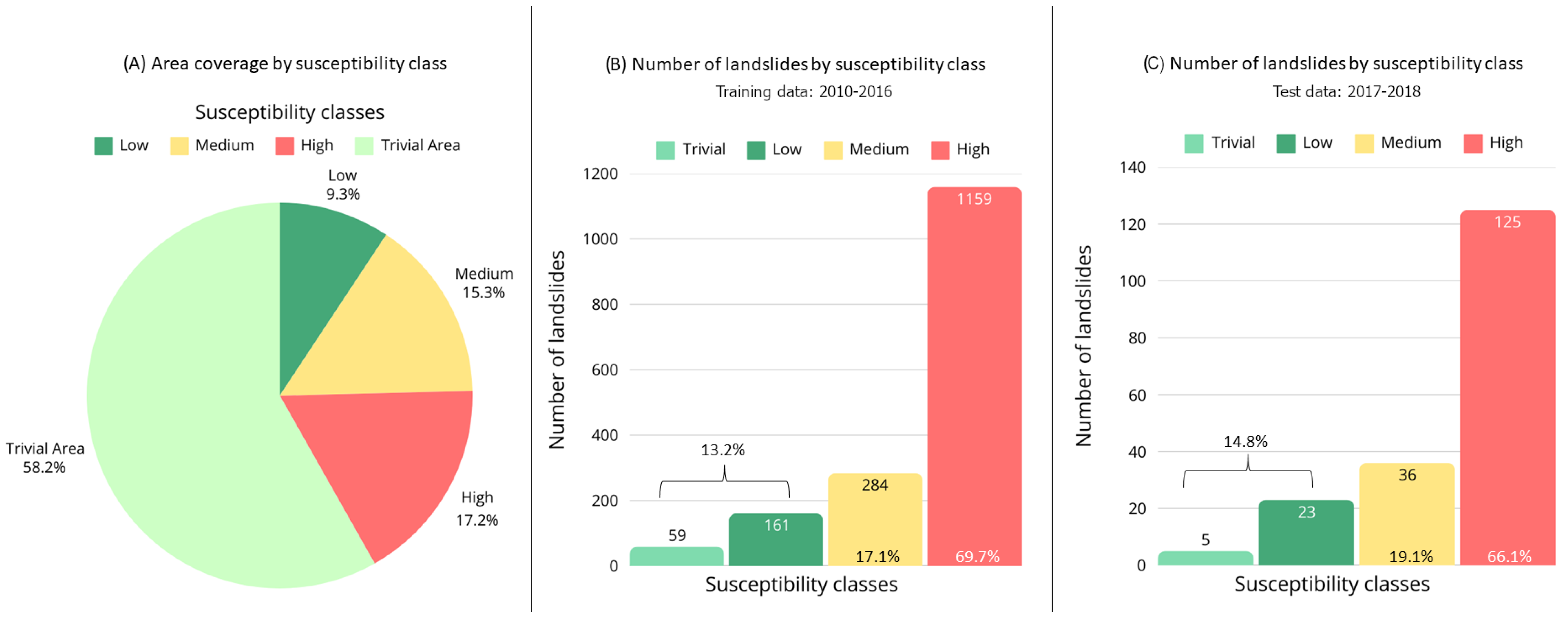



| Parameter | Value |
|---|---|
| Value field | Elevation |
| Interpolation type | Binning |
| Cell assignment | Average |
| Void fill method | Linear |
| Output data type | Floating Point |
| Sampling type | Cell Size |
| Sampling value | 5 |
| Z factor | 1 |
| Validation Type | Landslide Inventory Period | AUROC |
|---|---|---|
| Random CV | 2011–2016 | 0.769 |
| Spatial CV | 2011–2016 | 0.736 |
| External | 2017–2018 | 0.847 |
| Training Sample (2010–2016) | Test Sample (2017–2018) | |
|---|---|---|
| Reference Map | ||
| Low susceptibility | 14.9% | 12.2% |
| Medium susceptibility | 54.3% | 55.5% |
| High susceptibility | 30.8% | 32.3% |
| Experimental Data-Driven Map | ||
| Low susceptibility | 13.2% | 14.8% |
| Medium susceptibility | 17.1% | 19.1% |
| High susceptibility | 69.7% | 66.1% |
Disclaimer/Publisher’s Note: The statements, opinions and data contained in all publications are solely those of the individual author(s) and contributor(s) and not of MDPI and/or the editor(s). MDPI and/or the editor(s) disclaim responsibility for any injury to people or property resulting from any ideas, methods, instructions or products referred to in the content. |
© 2025 by the authors. Published by MDPI on behalf of the International Society for Photogrammetry and Remote Sensing. Licensee MDPI, Basel, Switzerland. This article is an open access article distributed under the terms and conditions of the Creative Commons Attribution (CC BY) license (https://creativecommons.org/licenses/by/4.0/).
Share and Cite
Lima, P.H.M.; Teixeira Coelho, L.C.; Raposo, G.D.; Badolato, I.d.S.; da Fonseca, R.B.M.; Silva, S.M.L.; Falcão, J.G.M. Assessing the Available Landslide Susceptibility Map and Inventory for the Municipality of Rio de Janeiro, Brazil: Potentials and Challenges for Data-Driven Applications. ISPRS Int. J. Geo-Inf. 2025, 14, 330. https://doi.org/10.3390/ijgi14090330
Lima PHM, Teixeira Coelho LC, Raposo GD, Badolato IdS, da Fonseca RBM, Silva SML, Falcão JGM. Assessing the Available Landslide Susceptibility Map and Inventory for the Municipality of Rio de Janeiro, Brazil: Potentials and Challenges for Data-Driven Applications. ISPRS International Journal of Geo-Information. 2025; 14(9):330. https://doi.org/10.3390/ijgi14090330
Chicago/Turabian StyleLima, Pedro Henrique Muniz, Luiz Carlos Teixeira Coelho, Guilherme Damasceno Raposo, Irving da Silva Badolato, Raquel Batista Medeiros da Fonseca, Sonia Maria Lima Silva, and Jonatas Goulart Marinho Falcão. 2025. "Assessing the Available Landslide Susceptibility Map and Inventory for the Municipality of Rio de Janeiro, Brazil: Potentials and Challenges for Data-Driven Applications" ISPRS International Journal of Geo-Information 14, no. 9: 330. https://doi.org/10.3390/ijgi14090330
APA StyleLima, P. H. M., Teixeira Coelho, L. C., Raposo, G. D., Badolato, I. d. S., da Fonseca, R. B. M., Silva, S. M. L., & Falcão, J. G. M. (2025). Assessing the Available Landslide Susceptibility Map and Inventory for the Municipality of Rio de Janeiro, Brazil: Potentials and Challenges for Data-Driven Applications. ISPRS International Journal of Geo-Information, 14(9), 330. https://doi.org/10.3390/ijgi14090330







